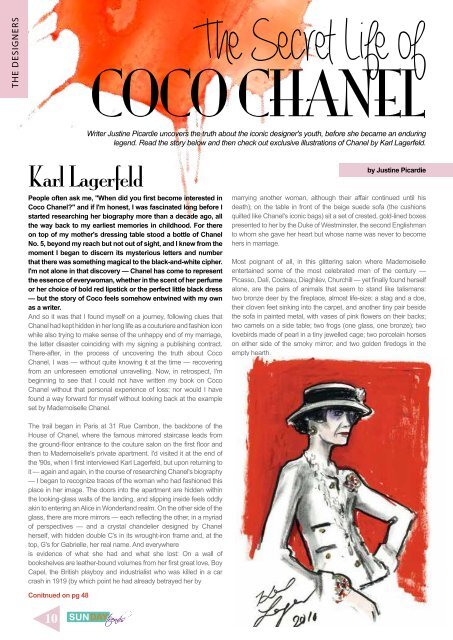You also want an ePaper? Increase the reach of your titles
YUMPU automatically turns print PDFs into web optimized ePapers that Google loves.
THE DESIGNERS<br />
The Secret Life of<br />
COCO CHANEL<br />
Writer Justine Picardie uncovers the truth about the iconic designer's youth, before she became an enduring<br />
legend. Read the story below and then check out exclusive illustrations of Chanel by Karl Lagerfeld.<br />
Karl Lagerfeld<br />
People often ask me, "When did you first become interested in<br />
Coco Chanel?" and if I'm honest, I was fascinated long before I<br />
started researching her biography more than a decade ago, all<br />
the way back to my earliest memories in childhood. For there<br />
on top of my mother's dressing table stood a bottle of Chanel<br />
No. 5, beyond my reach but not out of sight, and I knew from the<br />
moment I began to discern its mysterious letters and number<br />
that there was something magical to the black-and-white cipher.<br />
I'm not alone in that discovery — Chanel has come to represent<br />
the essence of everywoman, whether in the scent of her perfume<br />
or her choice of bold red lipstick or the perfect little black dress<br />
— but the story of Coco feels somehow entwined with my own<br />
as a writer.<br />
And so it was that I found myself on a journey, following clues that<br />
Chanel had kept hidden in her long life as a couturiere and fashion icon<br />
while also trying to make sense of the unhappy end of my marriage,<br />
the latter disaster coinciding with my signing a publishing contract.<br />
There-after, in the process of uncovering the truth about Coco<br />
Chanel, I was — without quite knowing it at the time — recovering<br />
from an unforeseen emotional unravelling. Now, in retrospect, I'm<br />
beginning to see that I could not have written my book on Coco<br />
Chanel without that personal experience of loss; nor would I have<br />
found a way forward for myself without looking back at the example<br />
set by Mademoiselle Chanel.<br />
by Justine Picardie<br />
marrying another woman, although their affair continued until his<br />
death); on the table in front of the beige suede sofa (the cushions<br />
quilted like Chanel's iconic bags) sit a set of crested, gold-lined boxes<br />
presented to her by the Duke of Westminster, the second Englishman<br />
to whom she gave her heart but whose name was never to become<br />
hers in marriage.<br />
Most poignant of all, in this glittering salon where Mademoiselle<br />
entertained some of the most celebrated men of the century —<br />
Picasso, Dalí, Cocteau, Diaghilev, Churchill — yet finally found herself<br />
alone, are the pairs of animals that seem to stand like talismans:<br />
two bronze deer by the fireplace, almost life-size; a stag and a doe,<br />
their cloven feet sinking into the carpet, and another tiny pair beside<br />
the sofa in painted metal, with vases of pink flowers on their backs;<br />
two camels on a side table; two frogs (one glass, one bronze); two<br />
lovebirds made of pearl in a tiny jewelled cage; two porcelain horses<br />
on either side of the smoky mirror; and two golden firedogs in the<br />
empty hearth.<br />
The trail began in Paris at 31 Rue Cambon, the backbone of the<br />
House of Chanel, where the famous mirrored staircase leads from<br />
the ground-floor entrance to the couture salon on the first floor and<br />
then to Mademoiselle's private apartment. I'd visited it at the end of<br />
the '90s, when I first interviewed Karl Lagerfeld, but upon returning to<br />
it — again and again, in the course of researching Chanel's biography<br />
— I began to recognize traces of the woman who had fashioned this<br />
place in her image. The doors into the apartment are hidden within<br />
the looking-glass walls of the landing, and slipping inside feels oddly<br />
akin to entering an Alice in Wonderland realm. On the other side of the<br />
glass, there are more mirrors — each reflecting the other, in a myriad<br />
of perspectives — and a crystal chandelier designed by Chanel<br />
herself, with hidden double C's in its wrought-iron frame and, at the<br />
top, G's for Gabrielle, her real name. And everywhere<br />
is evidence of what she had and what she lost: On a wall of<br />
bookshelves are leather-bound volumes from her first great love, Boy<br />
Capel, the British playboy and industrialist who was killed in a car<br />
crash in 1919 (by which point he had already betrayed her by<br />
Conitnued on pg 48<br />
10

















